When a gemologist grades a diamond, he/she measures its proportions and then calculates the factors: depth percentage, table percentage, crown angle, pavilion angle, girdle and culet. These factors help to determine the diamond's cut grade, and are included on its grading report.
Every diamond has a distinct set of properties and proportions which defines its anatomy. The guide below will help you identify these areas.

Diamond anatomy (Structure).
The diameter is the width of a polished diamond that is measured from edge to edge, or the width of the diamond at the widest point of the girdle (in fancy cut diamonds, the smallest diameter is used).
The diamond's depth is the distance from the table to the culet. Along with table, depth is a critical attribute in determining a diamond's cut grade. Diamonds that are cut too deep (larger distance from table to culet) will result in light leakage. Deeper diamonds will also look visually smaller than other diamonds that may possess the same carat weight. This is because the carat weight is held in the depth of the diamond. Diamonds that are cut too shallow (shorter distance from table to culet) will also result in light leakage. Shallow diamonds tend to look larger than deeper diamonds because they spread the carat weight wider to the sides of the diamond, giving it more surface area. A shallower diamond can be a great thing, but the trade off is possibly light leakage or sparkle. The ideal range for a round cut diamond's depth is between 59% - 62.3% in order to optimize sparkle. Diamonds with a cut grade of Very Good and Ideal have a depth percentage within this range.
The depth percentage is one of the key factors in determining a diamond's grade of cut. Depth percentage is expressed as a ratio of the distance between the table to the culet and the diameter of the diamond measured across the girdle:
The diamond table is the largest and top-most facet of a gemstone in which light penetrates and escapes with sparkle and fire. It is the largest facet, regardless of the diamond's shape. The ideal range for the table facet in a round cut diamond is between 53% - 58%.
Table percentage is all about balancing the width of the table and the diameter of the diamond to produce optimal sparkle. If the width of the table is too large or small compared to the diameter of the diamond, the top of the diamond will appear flat or rounded, and either way sparkle is compromised.
A larger table can make a diamond look larger, because the reflection (not refraction) may be greater. A diamond's table refracts light rays downward as they enter the diamond. In turn, that light is reflected back up from the pavilion and through the table, thus, most of a diamond's light reaches an observer's eye through the table. The size of the table impacts the amount of light that can enter the diamond. It is therefore an important factor gemologists use when assigning a diamond a cut grade:
A diamond's crown is the top part of the diamond above the girdle. It is called the crown because it is at the height of the diamond and from a profile view, it resembles an upside down crown. The crown is where the maximum amount of light enters and escapes. The crown must be angled appropriately in order to bounce and reflect/refract light for maximum diamond sparkle and brilliance. A shallow crown or crown angle can look like a flat top, the top of the diamond could appear clear and glassy, increasing light leakage. A heavy or steep crown angle can reduce light penetration and decrease the diamond's sparkle when viewed from above. Diamonds cut with an optimal angle will yield more sparkle.
Most round diamonds have a crown angle between 30 - 35 degrees. The crown angle for a round Ideal cut diamond must be between 34.0 - 34.9 degrees.
The diamond pavilion is the bottom part of the diamond below the girdle. Like the crown, the diamond's pavilion must be correctly faceted and angled in order to refract light. Once light enters the crown, it is the pavilion's job to bounce light back to the eye, creating a sparkle effect. In the pavilion angles are too deep or shallow, light will fall through. Sparkle is merely the bounce back of light. If the light doesn't bounce back, sparkle is lost. The ideal pavilion angle for a round diamond is 42.8 - 43.2 degrees.
As with the crown angle, if the pavilion angle is too large, it will not emit notable sparkle. If it is too shallow, the diamond could appear glassy. When cut for brilliance, the pavilion will reflect the most sparkle to your eye through the top of the diamond.
The bulk of a diamond's weight is typically held in its pavilion. This means it is often considered the most valuable part of the diamond and yet its angles are more important than its size.
As mentioned, it is critical for a diamond's pavilion to be neither too deep or nor shallow. An overly deep pavilion brings a darkened effect to the diamond, since it does not reflect enough light back up to the observer's eye through the crown. A shallow pavilion creates a 'fish eye' effect if viewed from the table, caused by the girdle reflecting in the middle of the table, appearing dull and lacking in scintillation.
The culet (pronounced cue-let) is the very bottom of a diamond's pavilion. It is either a point or a tiny facet that lies parallel with the table (i.e. the top of the diamond). If a facet, it can be polished or left unpolished.

Diamond culet - The culet is a facet placed at the tip of the pavilion where the mains meet to reduce the risk of damage on loose diamonds. Although the definition of culet is limited to the facet located at the bottom of the pavilion, this term is commonly used to refer to this area in general.
If a culet is larger than average, it may affect the overall appearance of the diamond: When looking down through the table at the diamond, as when set in an engagement ring, a large culet may be visible. A large culet allows a greater amount of light to escape through the bottom of the diamond, rather than reflecting it back to the observer's eyes, resulting in a noticeable dark circle.
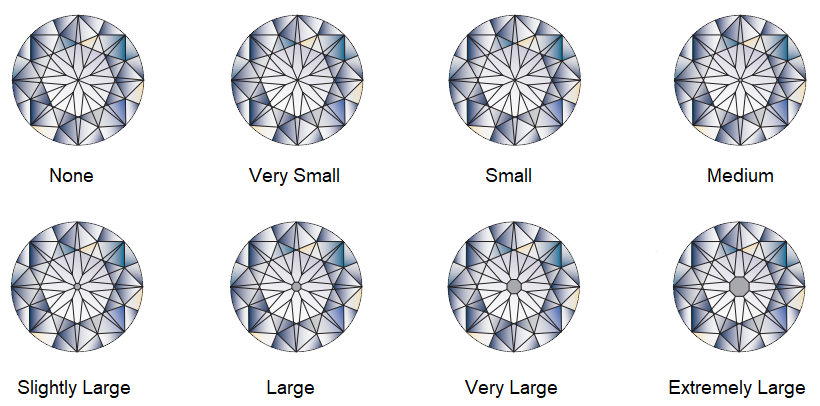
Diamond culet grades.
A diamond can either have a pointed culet, usually described as "none" on grading reports or an additional rough or polished facet parallel to the diamond's table. Diamonds with small culets are likely to exhibit the most brilliance.
Any diamond culet size of Medium or smaller will be invisible to the naked eye, and have no negative impact on a diamond's appearance. However, if a culet is Slightly Large or larger, it may allow light entering from the crown to pass straight through the culet facet, reducing the diamond's brilliance. This may also make the culet appear as an inclusion, or create a dead area on the diamond where the light is escaping through the bottom.
The presence of a culet adds a facet to the diamond's total number of facets. For example, a round brilliant cut diamond may have either 57 or 58 facets, meaning it has no culet in case of 57 facets and features a faceted culet in case of 58 facets.
In olden times large culets were a common feature of a diamond. For example, Old Mine and Old European cut diamonds always feature prominent culets. Today large culets are not desirable because culet provides an additional facet at the point of a diamond through which light can escape. This negatively affects a diamond's fire, brilliance and scintillation and diminishes the diamonds beauty.
Diamond culets is measured and graded on a culet scale below. The culet is graded by evaluating the point where the diamond closes under the pavilion under 10x magnification. The culet's grade is the size and presence of the opening under the pavilion. Culet is an important factor in a diamond's light performance and light leakage; therefore, it affects the diamond's cut grade.
When a loose diamond is sent for certification, a gemologist will typically measure the culet size through a non-contact optical measuring device or a gemological microscope. The face-up view allows determining the culet's size, while the side view allows detecting its angle:
The size of culets within the range of Small to Extremely Large can also be expressed as a percentage relative to the average diameter of the diamond, measuring from approximately 1.5% to 15%.
The culet is described according to its size. The GIA uses an 8-grade system to rate culets. Every reputable jeweller displays the culet size as determined by the GIA, using the following scale:
| Diamond Culet Scale |
|---|
| None |
| Very Small |
| Small |
| Medium |
| Slightly Large |
| Large |
| Very Large |
| Extremely Large |
Diamond culet scale.
None: There is no opening under the pavilion so light cannot leak from the culet and is reflected back. This is a requirement for excellent cut grade diamonds.
Very Small: The culet has a tiny open not visible without magnification. Light leakage is minimal and not enough to impact the diamond's sparkle and light performance.
Small: The culet has a visible opening under magnification that leaks a small amount of light. The diamond will still have high brilliance and sparkle.
Medium: A noticeable opening is visible under magnification and small without it. The diamond will lose light performance as light escapes through the pavilion's center.
Large: The culet is noticeable open and acts like a facet. Light leakage occurs and brilliance is affected. Typically, Old European and Old Mine cut diamonds have large, open culets
Very Large & Extremely Large: A large opening is obvious and present in the diamond. You'll never see this in a brilliance cut or modern cut diamond. Old Mine and Old European cut diamonds may have very large culets.
GIA laboratory graders look at a diamond face-up and through 10x magnification. This means that they are looking at the diamond through the table facet. They then assign a grade to the culet based on it's appearance in relation to the rest of the diamond facets. If the diamond does not have a culet facet, the size is listed as none. Additionally, if the culet is at a greater angle to the table facet, misaligned, it is listed as a an extra fact on the diamond. This factor can be observed by looking at the diamond at an angle. If there is a clarity imperfection in the culet such as an indented natural, chip or cavity, only the remaining portion of the culet is used to assign a grade. Graders use magnification, and photographic references to ensure that the culet grade is accurate.
There is a debate going on among jewellers about whether a diamond should have a culet or not. There are arguments for and against it, which is why no uniform exists.
First of all, let's clarify that the main purpose of the culet is to prevent damage to the point and protect the diamond. Although diamond is the hardest known mineral (10 on the Mohs scale), the pointed end is at risk of cracking or breaking if accidentally hit.
The culet plays a significant role in a diamond's light performance and appearance. Large culets are visible through the table as dark circles and allow light to escape through the bottom of a diamond. This negatively affects a diamond's sparkle and brilliance. Larger, open culets leak light from the pavilion whereas closed or none graded culets reflect light as required. Today, modern fancy shapes and brilliant cut diamonds tend to have closed or none culets. With greater technology and cutting precision, diamond manufacturer's understand the requirements to close the diamond's culet. Culet is often neglected because it is require to find open culet diamonds. These are most typically found in Old European and Old Miner cut diamonds, with antique look and more traditional diamond cuts.
Because a culet is pointed and closed, it is sharp and can be broken from high or hard impact. The culet is the most vulnerable part of a diamond, commonly susceptible to breaking. When set in jewellery, it is protected and unlikely to be harmed. A chipped culet is noticeable because it is located directly below the diamond's table.
According to modern cutting standards, the absence of a culet is more desirable. However, a pointed culet can easily be broken from high impact or when mounting the diamond into a setting. In fact, the culet is the most vulnerable part of a diamond, so it is necessary to secure the diamond in a protective setting to minimize the risk.
If you prefer to have a diamond with a faceted culet, it is better to go with Very Small or Small grades as these fall within the Excellent range. In case the culet is any larger, it will affect the diamond appearance. This is especially true for bigger diamonds, as large culets will look like a dark circle.
The girdle is the widest part of a diamond: the outermost edge where the crown and pavilion connect. When placed in a halo or bezel engagement ring setting, the girdle is typically hidden and level with the metal as it meets the diamond. In a prong or channel set engagement ring, the girdle can be seen where no metal touches the diamond. Gemologists consider a diamond's girdle width when assigning a cut grade. If the girdle is too thin or too thick, they will only assign a Very Good or Good cut grade to diamonds even if they have plenty of sparkle and structural stability.

Diamond girdle.
A girdle may be faceted (a series of tiny polished sides going around the diamond), bruted (a single continuous unpolished surface going round the diamond; no longer common), or polished (a bruted girdle that has been polished smooth). Whether a girdle is faceted, bruted, or polished usually has no impact on the appearance or value of the diamond.
As mentioned, a diamond's girdle is a contributing factor in a diamond's cut grade. The girdle is where the diamond is set and held securely in place in a piece of jewellery. The girdle reduces the risk of damage on the diamond when jewellers work with it. A standard round diamond has 16 "valley" and 16 "hill" poistions, see image above, where the girdle rises and falls. Girdle thickness is reported as a range of thick to thin. Today, it is more common to have polished and faceted girdles. In some fancy shapes such as emerald cuts and asscher cuts, girdles are polished but not faceted.
The girdle is described according to its width. Often, the width of the girdle varies at different points around the diamond, and is quoted in a range designating the thinnest and thickest point along the girdle (e.g. "Thin-Medium" means the diamond's girdle varies in width from thin at the narrowest point to medium at the widest point). Each reputable jeweller displays the girdle width as determined by the GIA, using the following scale:
| Diamond Girdle Thickness Scale |
|---|
| Extremely Thin |
| Very Thin |
| Thin |
| Medium |
| Slightly Thick |
| Thick |
| Very Thick |
| Extremely Thick |
Diamond girdle thicknes scale.

Diamond girdle thickness.
Like other diamond attributes, the girdle also has a grading scale. The girdle is graded by evaluating that center portion in a profile view at 10x magnification. The girdle's grade is the largest and smallest part of the girdle size. Girdles are typically not perfectly even around the diamond, thus they are given 2 grades:
Extremely Thin: The girdle is very, very small, almost not visible. It may be susceptible to chipping or breaking. It will have a significant impact on the cut grade of the diamond. Diamond depth may be shallow.
Very Thin: The girdle is thin and care is required when setting the diamond as risk remains of chipping it. A Very Thin girdle grade cannot result in an excellent cut grade. Diamond depth may be shallow.
Thin, Medium: A perfect girdle is seen. The risk of chipping is minimal and the cut grade is not adversely affected. The diamond's depth is not too depth as a result of the girdle. There are also combinations such as thin-medium.
Slightly Thick: The girdle is near perfect. The risk of chipping is minimal and the cut grade is not adversely affected. The diamond's depth is not too depth as a result of the girdle.
Thick: The girdle is thicker than desirable. It can very slightly increase the diamond's depth and will often result in a Very Good cut grade.
Very Thick: The girdle is much thicker than desired. It will often yield high depth and reduce the cut grade to Very Good or Good. It is possible that the girdle's reflection may be seen within the diamond.
Extremely Thick: The girdle is much thicker than recommended. It can affect the diamond's symmetry and will reduce the cut grade to Good or Fair. It will almost surely result in a " fish eye" effect, where a reflection of the girdle will be visible in the diamond. This has an adverse affect on diamond sparkle.
As mentioned, girdle grade is assigned by looking at the thickest and thinnest aspects aspects of the diamond girdle. Girdle is graded by looking at the diamond through an optical measuring device or microscope.The measurements can be shown as a percentage relative to the average diameter of the diamond. However, the final grade is assigned by visually looking at the girdle and it's shaping. Girdle is viewed both faceup and at an angle to determine the grade:
Girdle thickness is evaluated based on the range from the thinnest to thickest valley positions. Valley positions are the thin areas located where the upper and lower half facets come closest.
If the thinnest and thickest points fall into the same category, a single rating is given. However, in most cases, girdles are rated as a range to cover the variance between the thinnest and thickest points, for example, Very Thin to Thick.
Diamond girdle ratings are relative to the size of the diamond, For example, a 0.50 ct diamond with a 0.31 mm girdle may be assigned a "Very Thick" grade. While a 5.00 ct diamond with the same girdle thickness will result in "Thin - Medium" range.
Being the widest part of any polished diamond, the girdle functions as the setting edge and plays an important role when measuring diamond proportions.
To determine how well a diamond is cut the other parts of the diamond are compared with the girdle in terms of size. For example, diamond table, diamond total depth, crown height, pavilion depth and culet size are expressed as a percentage of the girdle:
All these measurements determine how close the cut of a diamond is to the ideal proportions since an ideal-cut diamond has optimal proportions to maximize its brilliance and sparkle. The girdle is also an ideal location for laser inscriptions that help identify a particular diamond among others without affecting its appearance.
As mentioned, There are three different types of diamond girdle: rough (also referred to as unpolished or bitted), polished and faceted.
In old times, diamond girdles were left unpolished in their original condition after the bruting process, where two diamonds are rotated against each other to give them a round outline. That is why rough girdles are also referred to as "bruted". Such girdles have a frosted appearance and tend to absorb dirt and oils, requiring more frequent cleaning as a result.
If too much pressure is applied during the bruting stage, a diamond girdle can get lots of micro feathers that look like tiny hairs. Such rough girdles are referred to as "bearded".
Nowadays, with the advent of diamond cutting techniques, polished and faceted girdles are seen more frequently. Rectilinear (princess) and step-cut diamonds (emerald and asscher) almost always have flat polished girdles, while roundish diamonds (round, oval, pear and heart) usually feature faceted girdles.
Unpolished Girdle

Less common in today's diamonds, unpolished girdles have rough skin and are not recommended for optimal girdle light performance.
Polished Girdle

Typically found on step cuts and princess cut diamonds due to larger, open faceting styles. Also can be found on round diamonds. They are acceptable for light performance.
Faceted Girdle
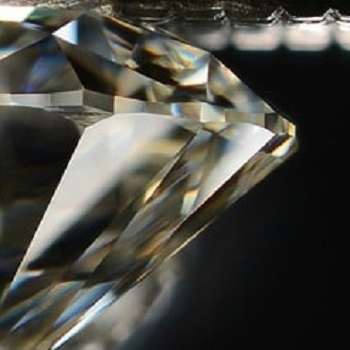
The best and most popular with today's diamond cutters is a faceted girdle that helps maximize diamond light performance and sparkle. The most recommended style of girdle.
Girdle types.
The thickness of the girdle affects the relative position of the surrounding facets, and so can impact cut. Because girdle width is already factored into the diamond's overall cut grade, a diamond graded as well cut will produce superior brilliance, fire, and scintillation, even if the girdle itself is not in the ideal Thin-Slightly Thick range of width.
A thicker girdle will add weight to a diamond, thereby increasing its price. Since a thick girdle adds depth to a diamond but not width, a thick girdled diamond will not appear any larger when viewed from the top (e.g. when set in a piece of jewellery), despite the additional carat weight. The effect on carat weight and price is minimal, but real.
An Extremely Thin girdle is more susceptible to chipping, and for that reason should be avoided for diamonds that are to be set in a ring. Earrings or pendants are less exposed to rough contact and so are less susceptible to chipping around the girdle. Avoid both Extremely Thin and Very Thin girdles in princess cut diamonds, as this shape already has sharp corners more prone to chipping. If you do purchase a princess cut diamond with a Very Thin girdle, consider setting it in a style that covers and protects the corners.
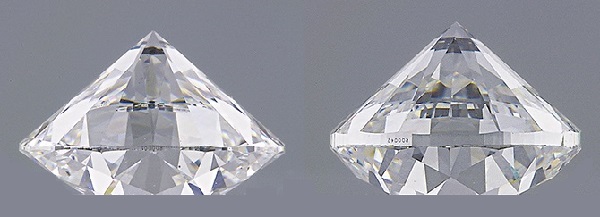
A thick girdle (right) adds weight to a diamond. The diamond on the right is heavier, yet will appear no larger when set in a ring.
In round cut diamond, the girdle will require more consideration as it has a direct impact on the cut grade of the diamond. In fancy shapes, however, the girdle often has little impact and does not require much consideration. The ideal range for a girdle is Medium-Slightly Thick in round cut diamonds. These diamonds are perfectly cut and proportionate. The diamond sparkle is not affected. In fancy shapes, it is Thin-Thick. If the girdle is completely uneven (for example, Extremely Thin to Extremely Thick), the diamond's symmetry will be disproportionate and adversely affected.
With very small girdles, the largest concern is breakage or chipping during the diamond setting process. The girdle hold the diamond securely in place in jewellery. Because heat and pressure are applied in the setting process, an extremely thin girdle can chip the diamond. On the other side, an extremely thick girdle may mean too much carat weight is trapped in the center of the diamond and so the depth is too much. This will mean the diamond will look smaller than its carat weight and the girdle may create gray reflections in the diamond, which will reduce the diamond's brilliance and make it visually duller.
Fancy shaped diamonds tend to have thicker girdles, especially cushion cut diamonds. It is thickest at the corners. For step cuts and princess cuts, thicker girdles are common, but usually on one or two sides. It is used as a means of clarity exclusion and weight preservation. Thickening it reduced rough diamond wastage, which can increase the diamond value due to higher carat weight. To identify the size, it is graded from the largest or thickest point and the thinnest point.
You'll often find that gemstones such as rubies, emeralds and sapphires also have very thick girdles.
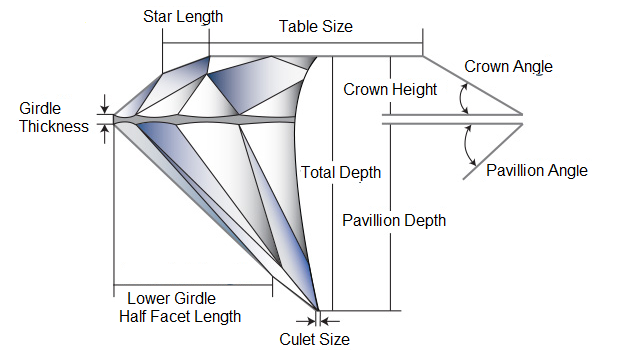
Round cut diamond structure - proportions.
The three diamonds below illustrate the difference between a diamond with the correct proportions and diamonds that are too shallow or too deep:
Diamond Too Shallow

Shallow Cut - Poor Brilliance.
Depth percentage too shallow: 56.5% and below.
Table percentage too low.
Crown and pavilion angles too shallow.
Ideal Diamond

Ideal Cut - Most Brilliance.
Depth percentage is ideal for maximum sparkle: 59 - 62.3%.
Table percentage is ideal.
Crown and pavilion angles are optimal.
Diamond Too Deep

Deep Cut - Poor Brilliance.
Depth percentage too deep: 65% and above.
Table percentage too high.
Crown and pavilion angles too large.
The percentages above are specific to a round shaped diamond. The ideal proportions for other diamond shapes are all slightly different.
A Facet is a surface or 'face' created when the diamond is cut:
Star Facets: Triangular shaped facets surrounding the table which form a star-shape when viewed from above.
Kite (Bezel) Facets: Facets shaped like a four-sided kite which extend from the table to the girdle. Sometimes referred to as Bezel Facets.
Upper Girdle Facets: The 16 triangular facets that sit directly on top of the girdle.
Lower Girdle Facets: The 16 triangular facets that sit directly below the girdle.
Pavilion Main Facets: The 8 large four-sided facets which run from the girdle to the culet.

Round cut diamond characteristics - facets.
Top View
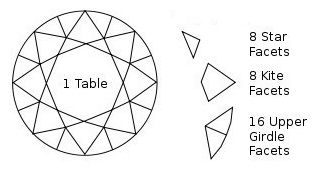
Bottom View

Round cut diamond facets.